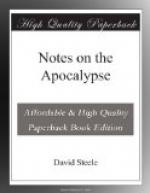In these first ten verses are contained the characteristics of that beast whose origin is given, ch. xi. 7. There we had no particular description of this personage; only he was the agent by whom the witnesses were opposed in open warfare, and by whom they were finally killed. Now we have a more full account of his origin, character, achievements and duration. This personage is denominated a “beast.” So are designated other characters, who are very different from this, (ch. iv. 6.) In that place we intimated that the authorized version is imperfect; and that either “living creatures” or simply “animals,” which latter we prefer, is that which the reader is to understand from the original word. Not only are the “four animals” different in origin, nature and agency from the “beast;” but in all these respects they are morally opposite. This is a ravenous beast; a beast of prey. Elsewhere the word is translated a “wild beast,” a “venomous beast,” a “viper.” (Acts x. 12; xxviii. 4.) This beast is the same which appeared in vision to the prophet Daniel, (ch. vii. 3.) Of the four great beasts which that prophet saw, this is the last. All the preceding are described by their resemblance to some known animals, but each is ferocious,—“a lion, bear, leopard.” The fourth is a nondescript; there is no species in the animal kingdom that can represent it; only it was “diverse from all the beasts that were before it,” (v. 7.) These four beasts represent “four kings,” (v. 17,) that is, “kingdoms,” (v. 23,) or dynasties. Now all interpreters agree that these four dynasties are the same as those symbolized in Nebuchadnezzar’s dream, (ch. ii. 31-43.) The different parts of the “image” answer to the four beasts; and these again are the symbols of the Babylonian, Medo-Persian, Grecian and Roman empires. Thus far, all sober expositors are agreed. Also, there is a like agreement that John’s first beast identifies with Daniel’s fourth,—the Roman empire. This is obvious from the general description by both prophets,—“having seven heads and ten horns.” (Dan. vii. 7; Rev. xiii. 1.)




